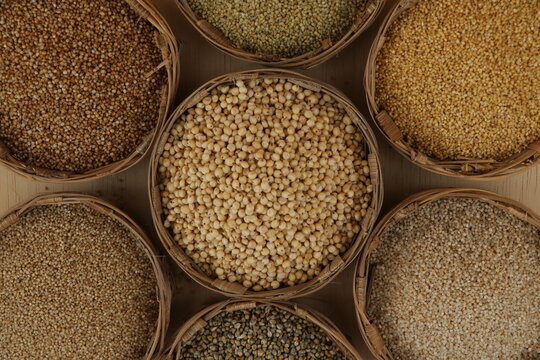

The Nutritional Powerhouse: Unleashing the Benefits of Millet Flour
Millet flour is a versatile and nutritious alternative to traditional flours. Derived from the small-seeded grass crop known as millet, this flour has gained popularity in recent years due to its unique health benefits and gluten-free properties. Millet flour is rich in essential nutrients and offers a range of culinary possibilities. In this article, we will explore what millet flour is, its nutritional value, and the various ways it can be used in cooking.
What is millet flour and its nutritional value?
Millet flour is made by grinding millet seeds into a fine powder. Millet, a small-seeded grass crop, is a staple food in many parts of the world, particularly in Africa and Asia. This ancient grain is gluten-free, making it an excellent choice for individuals with gluten sensitivities or those following a gluten-free diet.
In terms of nutritional value, millet flour is a powerhouse. It is high in fiber, which aids in digestion and helps to regulate blood sugar levels. Millet flour is also rich in essential minerals such as magnesium, phosphorus, and potassium, which are important for bone health, nerve function, and maintaining a healthy heart. Additionally, millet flour contains B vitamins, including niacin and thiamine, which play a crucial role in energy production and brain function.
Health benefits of millet flour
The health benefits of millet flour are numerous and diverse. Firstly, millet flour is a great source of antioxidants, which help to protect the body against harmful free radicals and reduce the risk of chronic diseases such as cancer and heart disease. The high fiber content of millet flour promotes healthy digestion and can aid in weight management by increasing feelings of fullness and reducing overeating.
Moreover, millet flour has a low glycemic index, meaning it does not cause a rapid spike in blood sugar levels. This makes it an ideal choice for individuals with diabetes or those looking to manage their blood sugar levels. Millet flour is also rich in iron, making it a valuable addition to the diet of individuals who are at risk of iron deficiency or anemia.
How to use millet flour in your cooking
Millet flour can be used in a variety of ways in the kitchen. Its mild, slightly nutty flavor makes it a versatile ingredient in both sweet and savory recipes. When baking, millet flour can be substituted for all-purpose or wheat flour in a 1:1 ratio. It adds a unique texture and flavor to bread, muffins, and cookies.
In savory dishes, millet flour can be used as a thickening agent in soups, stews, and sauces. It can also be used to make delicious gluten-free pancakes, crepes, or homemade pasta. Additionally, millet flour can be used as a coating for fish or chicken, adding a crispy texture to your favorite dishes.
Where to buy millet flour online
Instead of searching high and low for it, consider Naario's 9-in-1 flour mix. You can find it on Naario’s website and on popular online stores like Amazon, BigBasket, Flipkart, JioMart, and OneGreen. This flour mix is a great option for cooking because it's versatile and saves you the trouble of hunting for millet flour of uncertain quality.
Understanding different types of millet flour
There are several different types of millet flour available, each with its own unique flavor and texture. The most common types include pearl millet flour, finger millet flour, and foxtail millet flour. Pearl millet flour has a slightly sweet flavor and is often used in baking. Finger millet flour has a rich, nutty flavor and is commonly used in traditional Indian cuisine. Foxtail millet flour has a mild flavor and can be used in a variety of dishes.
Exploring the benefits of mixed millet flour
Mixed millet flour, as the name suggests, is a combination of different millet flours. This blend offers a wider range of flavors and textures, making it a popular choice for individuals who enjoy experimenting in the kitchen. Mixed millet flour provides a balanced nutritional profile and can be used in various recipes, from bread and pancakes to porridge and desserts.
Tips for baking with millet flour
When baking with millet flour, there are a few tips to keep in mind to ensure the best results. Firstly, it is recommended to combine millet flour with other gluten-free flours such as rice flour or almond flour to improve the texture and rise of baked goods. Adding xanthan gum or guar gum can also help to bind the ingredients together and create a lighter, fluffier texture.
Additionally, it is important to note that millet flour can have a slightly grainy texture, so it is advisable to sift the flour before using it in recipes. This will help to remove any lumps or clumps and ensure a smoother consistency in the final product. Lastly, it is recommended to store millet flour in an airtight container in a cool, dry place to maintain its freshness and prevent it from becoming rancid.
Choosing the best millet flour for your needs
When selecting millet flour, it is important to consider your specific dietary requirements and preferences. If you have celiac disease or a gluten intolerance, be sure to choose a certified gluten-free millet flour to avoid any potential cross-contamination. Organic millet flour is also available for those who prefer to incorporate organic products into their diet.
Furthermore, it is a good idea to read product reviews and check the nutritional information before making a purchase. Look for millet flour that is high in fiber and protein, as well as being free from any additives or preservatives. By selecting the best millet flour for your needs, you can ensure that you are getting the most out of this nutritional powerhouse.
Naario's 9-in-1 flour mix is a unique blend that combines the goodness of nine super grains. Each grain offers distinct health benefits, making this flour mix a wholesome choice for your cooking needs. With ingredients like chana, flaxseeds, oats, ragi, maize, foxtail millet, pearl millet, barley, and soybean, Naario's flour mix provides a nutritious boost to your meals. Whether you're looking for plant protein, antioxidants, heart health support, or dietary fiber, this versatile blend has you covered.
Conclusion: Embracing the versatility and health benefits of millet flour
In conclusion, millet flour is a nutritional powerhouse that offers a wide range of health benefits. It is a gluten-free alternative to traditional flours and is packed with essential nutrients. From its high fiber content to its antioxidant properties, millet flour can support a healthy digestive system, regulate blood sugar levels, and reduce the risk of chronic diseases.
Furthermore, millet flour can be used in a variety of ways in the kitchen, from baking bread and cookies to thickening soups and sauces. With its mild, nutty flavor and unique texture, millet flour adds a delicious twist to any recipe. By incorporating millet flour into your cooking, you can enjoy the versatility and health benefits of this nutrient-dense ingredient.
So why not give it a try? Start experimenting with millet flour in your favorite recipes and explore the endless possibilities it offers. Whether you choose to bake with it, cook savory dishes, or even try a mixed millet flour blend, you are sure to discover a new world of flavors and nutritional benefits. Embrace the power of millet flour and elevate your culinary creations to new heights.
1 comment
-
Good information
Aisha on
